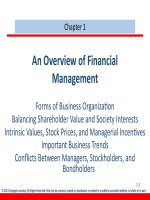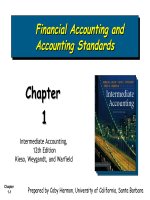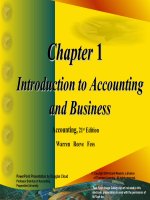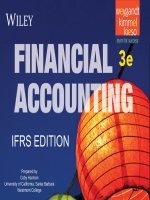Financial accounting 3e IFRS edtion willey chapter 01
Bạn đang xem bản rút gọn của tài liệu. Xem và tải ngay bản đầy đủ của tài liệu tại đây (1.38 MB, 79 trang )
WILEY
IFRS EDITION
Prepared by
Coby Harmon
University of California, Santa Barbara
1-1
Westmont College
PREVIEW OF CHAPTER 1
Financial Accounting
IFRS 3rd Edition
Weygandt ● Kimmel ● Kieso
1-2
CHAPTER
1
Accounting in Action
LEARNING OBJECTIVES
After studying this chapter, you should be able to:
1-3
1
Explain what accounting is.
2
Identify the users and uses of accounting.
3
Understand why ethics is a fundamental business concept.
4
Explain accounting standards and measurement principles.
5
Explain the monetary unit assumption and the economic entity assumption.
6
State the accounting equation, and define its components.
7
Analyze the effects of business transactions on the accounting equation.
8
Understand the five financial statements and how they are prepared.
What is Accounting?
Learning Objective 1
Accounting consists of three basic
Explain what accounting is.
activities—it
identifies,
records, and
communicates
the economic events of an organization to interested users.
1-4
LO 1
Three Activities
Illustration 1-1
The activities of the accounting process
The accounting process includes
the bookkeeping function.
1-5
LO 1
Assumptions
Review Question
Which of the following is not a step in the accounting process?
1-6
a.
Identification.
b.
Recording.
c.
Economic entity.
d.
Communication
LO 1
Who Uses Accounting Data?
INTERNAL USERS
Illustration 1-2
Questions that internal users ask
1-7
LO 1
Who Uses Accounting Data?
Learning Objective 2
Identify the users and uses
EXTERNALUSERS
of accounting.
Illustration 1-3
Questions that external users ask
1-8
LO 2
DO IT!
>
Indicate whether the following statements are true or false.
1.
The three steps in the accounting process are identification, recording, and communication.
2.
Bookkeeping encompasses all steps in the accounting process.
3.
Accountants prepare, but do not interpret, financial reports.
4.
The two most common types of external users are investors and company officers.
5.
Managerial accounting activities focus on reports for internal users.
Solution:
1-9
1.
2.
True
3.
4.
5.
False
False
False
True
LO 2
The Building Blocks of Accounting
Learning Objective 3
Ethics in Financial Reporting
Understand why ethics is a
fundamental business
concept.
Standards of conduct by which one’s actions are judged as right or wrong,
honest or dishonest, fair or not fair, are ethics.
Recent financial scandals include: Enron (USA), Parmalat (ITA), Satyam Computer Services
(IND), AIG (USA), and others.
1-10
Effective financial reporting depends on sound ethical behavior.
LO 3
Ethics in Financial Reporting
Illustration 1-4
Steps in analyzing ethics cases and situations
1-11
LO 3
Ethics Insight
Dewey & LeBoeuf (USA)
I Felt the Pressure—Would You?
“I felt the pressure.” That’s what some of the employees of the now-defunct law firm of Dewey & LeBoeuf LLP (USA)
indicated when they helped to overstate revenue and use accounting tricks to hide losses and cover up cash shortages.
These employees worked for the former finance director and former chief financial officer (CFO) of the firm. Here are
some of their comments:
•
“I was instructed by the CFO to create invoices, knowing they would not be sent to clients. When I created these
invoices, I knew that it was inappropriate.”
•
“I intentionally gave the auditors incorrect information in the course of the audit.”
(continued)
1-12
LO 3
Ethics Insight
Dewey & LeBoeuf (USA)
I Felt the Pressure—Would You?
What happened here is that a small group of lower-level employees over a period of years carried out the instructions of
their bosses. Their bosses, however, seemed to have no concern as evidenced by various e-mails with one another in
which they referred to their financial manipulations as accounting tricks, cooking the books, and fake income.
Source: Ashby Jones, “Guilty Pleas of Dewey Staff Detail the Alleged Fraud,” Wall Street Journal (March 28, 2014).
1-13
LO 3
Accounting Standards
Learning Objective 4
Explain accounting standards
and the measurement principles.
International Accounting Standards Board (IASB)
/>
International Financial Reporting
Standards
Financial Accounting Standards Board (FASB)
/>
Generally Accepted Accounting Principles (GAAP)
1-14
LO 4
Measurement Principles
HISTORICAL COST PRINCIPLE (or cost principle) dictates that companies record assets at their
cost.
FAIR VALUE PRINCIPLE states that assets and liabilities should be reported at fair value (the price
received to sell an asset or settle a liability).
1-15
LO 4
Global Insight
The Korean Discount
If you think that accounting standards don’t matter, consider recent events in South Korea. International investors expressed concerns
that the financial reports of some South Korean companies were inaccurate. Accounting practices sometimes resulted in differences
between stated revenues and actual revenues. Because investors did not have complete faith in the accuracy of the numbers, they
were unwilling to pay as much for the shares of these companies relative to shares of comparable companies in different countries.
This difference in share price was referred to as the “Korean discount.” In response, Korean regulators decided to require companies
to comply with international accounting standards. This change was motivated by a desire to “make the country’s businesses more
transparent” in order to build investor confidence and spur economic growth. Many other Asian countries, including China, India,
Japan, and Hong Kong, have also decided either to adopt international standards or to create standards that are based on the
international standards.
Source: Evan Ramstad, “End to ’Korea Discount’?” Wall Street Journal (March 16, 2007).
1-16
LO 4
Assumptions
Learning Objective 5
Explain the monetary unit
MONETARY UNIT ASSUMPTION
assumption and the economic
entity assumption.
requires that companies include in the
accounting records only transaction data that
can be expressed in terms of money.
ECONOMIC ENTITY ASSUMPTION requires that activities of the entity be kept separate and distinct
from the activities of its owner and all other economic entities.
Proprietorship
Partnership
Forms of Business Ownership
1-17
Corporation
LO 5
Forms of Business Ownership
Proprietorship
Owned by one person
Owner is often manager/operator
Owner receives any profits,
Partnership
persons
suffers any losses, and is
personally liable for all debts
Owned by two or more
Corporation
Ownership divided into shares
Separate legal entity
Often retail and service-type
organized under corporation
businesses
law
Generally unlimited personal
Limited liability
liability
1-18
Partnership agreement
LO 5
Assumptions
Review Question
The historical cost principle states that:
a.
assets should be initially recorded at cost and adjusted when the fair value changes.
b.
activities of an entity are to be kept separate and distinct from its owner.
c.
assets should be recorded at their cost.
d.
only transaction data capable of being expressed in terms of money be included in the
accounting records.
1-19
LO 5
Accounting Across the Organization
Spinning the Career Wheel
One question that students frequently ask is, “How will the study of accounting help me?” A working knowledge of
accounting is desirable for virtually every field of endeavor. Some examples of how accounting is used in other careers
include:
General management: Imagine running Volkswagen (DEU), Saudi Telecom (SAU), a Subway (USA) franchise, or a
Fuji (JPN) bike shop. All general managers need to understand where the company’s cash comes from and where it
goes in order to make wise business decisions.
Marketing: Marketing specialists at a company like Hyundai Motor (KOR) develop strategies to help the sales force be
successful. But making a sale is meaningless unless it is profitable. Marketing people must be sensitive to costs and
benefits, which accounting helps them quantify and understand.
(continued)
1-20
LO 5
Accounting Across the Organization
Spinning the Career Wheel
Finance: Do you want to be a banker for Société Générale (FRA) or a financial analyst for ICBC (CHN)? These fields
rely heavily on accounting. In all of them, you will regularly examine and analyze financial statements. In fact, it is difficult
to get a good finance job without two or three courses in accounting.
Real estate: Are you interested in being a real estate broker for Sotheby’s International Realty (GBR)? Because a third
party—the bank—is almost always involved in financing a real estate transaction, brokers must understand the numbers
involved: Can the buyer afford to make the payments to the bank? Does the cash flow from an industrial property justify
the purchase price? What are the tax benefits of the purchase?
1-21
LO 5
>
DO IT!
Indicate whether each of the following statements presented below is true or false.
1.
Convergence refers to efforts to reduce differences between IFRS and U.S. GAAP.
2.
The primary accounting standard-setting body headquartered in London is the
True
International Accounting Standards Board (IASB).
True
3.
The historical cost principle dictates that companies record assets at their cost. In later
periods, however, the fair value of the asset must be used if fair value is higher than its
cost.
False
1-22
LO 5
>
DO IT!
Indicate whether each of the following statements presented below is true or false.
4.
Relevance means that financial information matches what really happened; the
information is factual.
5.
False
A business owner’s personal expenses must be separated from expenses of the
business to comply with accounting’s economic entity assumption.
True
1-23
LO 5
The Basic Accounting Equation
Learning Objective
6 State the accounting
Basic Accounting Equation
equation, and define its
components.
Provides the underlying framework for recording and summarizing
economic events.
Assets must equal the sum of liabilities and equity.
Assets
Assets
1-24
=
Liabilities
Liabilities
+
Equity
Equity
LO 6
Basic Accounting Equation
Assets
Assets
=
Liabilities
Liabilities
+
Equity
Equity
Assets
1-25
Resources a business owns.
Provide future services or benefits.
Cash, Inventory, Equipment, etc.
LO 6









